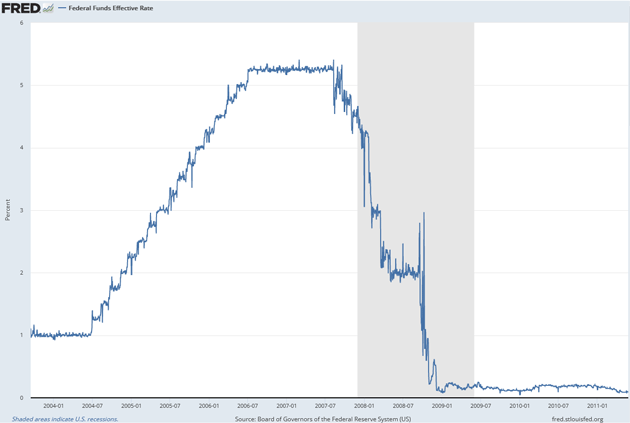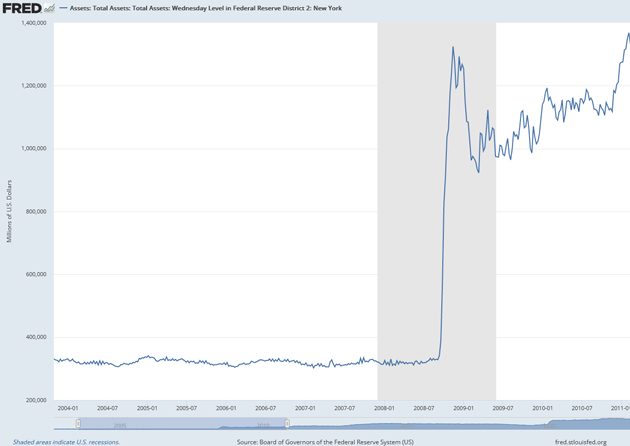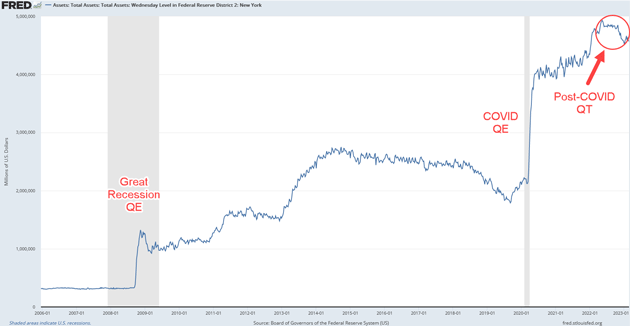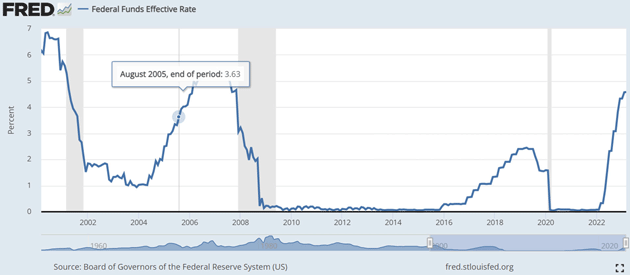How It Started & How It's Going

If you read and pay attention to the world, you probably know the recent past pretty well. And if you’re a history buff like me, you also know something about the more distant past.
In between, however, we often have a memory gap. Events from five, 10, or even 20 years ago slip out of mind but haven’t yet made it into the history books. They can fall into a valley as though they never happened. But they did happen, and they matter.
Lately the conversation has been about inflation, a possible recession, and how all this emerged from the pandemic. But it all traces back to events long before COVID-19. What happened in 2020 certainly changed the timing and some details, but the economy was slowing with an inverted yield curve in 2019.
The events of 2020 were on no one’s bingo card and we will debate them for years. Nevertheless, we are still on the road to the Great Reset, just at a faster clip. We can better understand this by recalling the 2008 crisis, the policy responses to it, and decisions made through the 2010's. Today, we’ll look at some of that in-between history and how it brought us to this point.
Memes and Easy Money
If you like social media memes, you’ve likely seen examples of “How It Started/How It’s Going.” Basically, this is where you show two pictures of the same person, first very sure of themselves, and then amid embarrassment or disaster.
These are amusing because we savor that schadenfreude feeling, but the memes make a good point, too: The line between confidence and arrogance, between intentions and results, can be a lot thinner than we think.
But there’s also a wrinkle to this: Often people try to appear confident even when they aren’t. Central bankers, for example, always have “credibility” in mind. In a fractional-reserve banking system, people must believe the lender of last resort is trustworthy. Maintaining that confidence is always the top priority.
Yet the reality in crisis periods is the Federal Reserve simply doesn’t know if its plans will work. No matter; they’re still unveiled with great confidence, which continues until they fail. Then the next plan is unveiled with equally great confidence, and the next, and the next.
Something like that happened in the Great Recession. We forget today exactly how that period unfolded, so let’s review the sequence. We can do this visually by following changes in the federal funds rate. Here it is from 2004 through 2010.

Source: FRED
The expansion period began with the Fed holding its main policy rate at 1%, where it had bottomed after the previous cycle. By summer of 2004, the Fed thought it was time to raise rates, and it did so steadily for the next two years. Whether that tempered growth is still unclear. It may be that the prospect of higher rates made people even more eager to buy homes (and lenders more eager to finance them) before rates rose further.
Regardless, in late 2007, it was pretty clear something was amiss. Deals were blowing up, fund managers were running into trouble, etc. Not seriously so, but enough to warrant a response. So began the rate cuts. Then in 2008, Bear Stearns imploded, followed months later by Lehman Brothers.
At every step along the way, Fed officials thought (as did many analysts) that they had the situation under control. The good times would surely resume shortly. They did not.
In late 2008, fed funds was approaching zero and people were asking, quite reasonably, what the Fed would do next. At the time, the “QE” (quantitative easing) that is now so familiar to us was just an obscure academic concept. It became more than academic in November 2008, when the Fed announced it would purchase $600 billion in agency mortgage-backed securities (Fannie Mae, etc.) and associated debt.
This, combined with the zero-bound fed funds rate reached the following month, was to be the solution.
(For the record, I was against taking rates to zero, let alone leaving them there. But I did agree with QE1, just not subsequent monetary expansions. Don’t even get me started on the bank bailouts, but in the middle of a crisis, no one had a playbook for a liquidity crisis in the US. They made decisions because they had to).
This chart is the Fed’s balance sheet assets for the same period as the rate chart above.

Source: FRED
Fed assets held steady at a kind of housekeeping level for years before going vertical at the end of 2008. And then something critical: A quick attempt to shrink the balance sheet a couple of months later ran into a brick wall. Free money turned out to be pretty popular.
In March 2009, the Fed expanded its MBS purchase program and added Treasury bond purchases as well. They initially framed these as temporary, with end dates and limited amounts. Very soon, though, it was clear those limits were just words. The Fed was trapped and would keep stimulating indefinitely.
That realization changed everything. It took the Fed from “How It Started” to “How It’s Going,” and set in motion a process that put us where we are today. It is not coincidence a massive bull market in stocks began in March 2009. Liquidity matters.
"Aggressive, Unprecedented Intervention"
Now let’s bring that data forward with a couple more charts: the same data, just brought up to date. Here are fed funds from 2006 to the present, with a few annotations.

Source: FRED
And here are Fed balance sheet assets for the same period.

Source: FRED
What looked like -- and was -- aggressive, unprecedented intervention in 2008‒2009 was quite mild compared to what followed. Six more years of zero rates and vast asset purchases, a half-hearted attempt to normalize before Jerome Powell “crawdadded” (walked backwards), as I called his seeming surrender to markets at the time.
Then two more years of ZIRP after COVID-19 struck, and now a rate “normalization” that still hasn’t reached what was “normal” in 2007 and “quantitative tightening” that has yet to make a significant dent in the balance sheet.
Put all that together, and you may begin to see why the current tightening cycle upsets so many investors. Until last year, many knew nothing but zero or very low rates and a stock market with highly favorable tailwinds. Even some graybeards let hope get the best of them, thinking it really was different this time.
But the years of easy money didn’t just boost markets. They changed the economy itself.
Mixed Signals
Charles Gave often observes how low interest rates change the way borrowers behave. When capital is expensive, they borrow to build new productive assets that will (they hope) generate self-sustaining cash flow. They open businesses, build factories, develop innovative new products, and so on. This adds up to GDP growth.
Conversely, cheap capital -- the kind artificially low interest rates provide -- incentivizes the use of borrowed money to buy existing assets, not new ones. That’s not necessarily bad, but it has different macro effects. Instead of GDP growth, it raises the price of the assets people are competing to buy.
Shares of stock are the best example. Unless it’s an IPO or other new offering, most stock investment doesn’t go to the company. It goes to some other shareholder, who naturally wants to get the highest price possible - as will you once you own that share. That's all well and good, but it doesn’t create any new productive capacity for the economy.
The same applies to companies. Rather than reinvest profits to grow the business, low interest rates make it more attractive to buy their competitors, or use borrowed cash to buy back their own shares. This, again, means lower investment in new capacity and increased industry concentration. With less competitive pressure, product quality and customer service can deteriorate even as prices rise.
My friend Lance Roberts recently surfaced an old Jeremy Grantham quote I’d forgotten:
“Profit margins are probably the most mean-reverting series in finance. And if profit margins do not mean-revert, then something has gone badly wrong with capitalism.”
For the record, I fully favor both capitalism and profits. The point here is that profits have an economic function. High profit margins signal opportunity exists in this sector or place, thereby drawing competitors to offer better products and prices. Consumers (i.e., all of us) enjoy the benefit. That’s how capitalism should work, but it recently hasn’t.
The easy-money era sent the wrong signals to politicians, too, making debt temporarily less daunting and encouraging all kinds of wasteful spending. Worse, government at all levels didn’t do what would have made perfect sense: use low long-term rates to finance much-needed infrastructure repairs and improvements. So now we are stuck with substandard roads, bridges, utilities, and other growth-inhibiting messes.
Now add to this the other inflation pressure that grew out of COVID-19 -- supply chain snafus, travel restrictions, etc. -- and the demographically-driven labor shortage. The inflation we see now makes perfect sense. The Fed and other central banks didn’t cause the pandemic, but they established the conditions that let it have these effects.
Worst of all, this “financial repression” favored investors but also punished savers. Not so long ago one could accumulate a nest egg, invest it in simple, low-risk bonds, and generate good income. That became impossible under ZIRP and still is today since inflation has overwhelmed the benefit of higher yields. It’s left many retirees in desperate positions, and it wasn’t an accident. It was a planned, intentional policy that started badly and only got worse.
Fooling with Mother Economic Nature
In the late 1970s, there was a classic commercial about Chiffon margarine fooling Mother Nature. It ended with, “It’s not nice to fool Mother Nature.” But that's exactly what the Federal Reserve has done since Greenspan. Let's detail the ways:
-
With a few exceptions, Greenspan left well enough alone in the 1990's. The dot-com mania was a “madness of crowds” event. An unrelenting 18-year bull market ended in a crash. And the Greenspan Fed did the theretofore unthinkable, taking rates to 1%. Greenspan explicitly targeted stock market returns. The markets, used to the “Greenspan Put,” rejoiced. And low rates, thought to boost the economy, had a perverse effect. The economy recovered, but the economic and business game changed.

Source: FRED
As noted above, messing with market rates distorts economic incentives. The driving force in capitalism has always been to maximize profits. With low rates, buying your competition rather than competing against them became the easier way to maximize profits.
That short-circuited Schumpeter’s creative destruction, a necessary if messy component of true capitalism, and reduced GDP growth. We clearly slapped Adam Smith’s invisible hand away from the playing table and instead let 12 people sitting around a table decide the world’s most important price: the price of money.
-
Low interest rates starve retirees and investors of reasonable returns. When rates are at zero, investors are forced to take more risk at precisely the time they should be getting more conservative.
-
Powell was not truly free to raise rates until his second term was confirmed on May 12, 2022 -- not if he wanted to get confirmed. Inflation had already begun to ramp up, and the Fed was way behind the curve. With the Federal Reserve keeping rates at zero too long and doing too much QE, combined with the massive over-stimulus of the economy by Congress, we are dealing with inflation that should not have been. But it is.
I know many feel the Fed should at a minimum pause the rate hikes and maybe even cut rates. The 20+-year attachment to low rates has distorted behaviors to the point that once-normal rates are difficult for many companies and private funds to manage.
I am perfectly comfortable with 5% interest rates when inflation is 4‒5%. I hope rates stay high enough to give investors a real return on their savings, and less incentive to buy your competition rather than actually invest and compete.
I truly hope we never once again feel that we have to get inflation to 2% because it is “only” 1.8%. What were we thinking? What is magic about 2% inflation? Inflation is destructive at any level.
Former BIS chief economist William White sent me this note as we were discussing the topic yesterday. It is from one of his essay’s quoting Paul Volcker’s autobiography in 2018.
“Whatever the motivation, the undesirable side effects of ultra-low rates are now being encouraged still further. The dangers arising from this policy were well summarized by the late Paul Volcker in his recent autobiography. He said ‘Ironically, the ‘easy money’ striving for a ‘little’ inflation as a means of forestalling deflation, could, in the end, be what brings it about.’”
It's not nice to fool around with market incentives. That Chiffon margarine commercial ended with an angry Mother Nature creating a thunderstorm. What kind of economic weather will we get from distorting the incentives of the free market?
More By This Author:
The PoV Revolution - How Companies Are Boosting Profits By Raising PricesDeficits Forever
The World Is Out Of Balance



